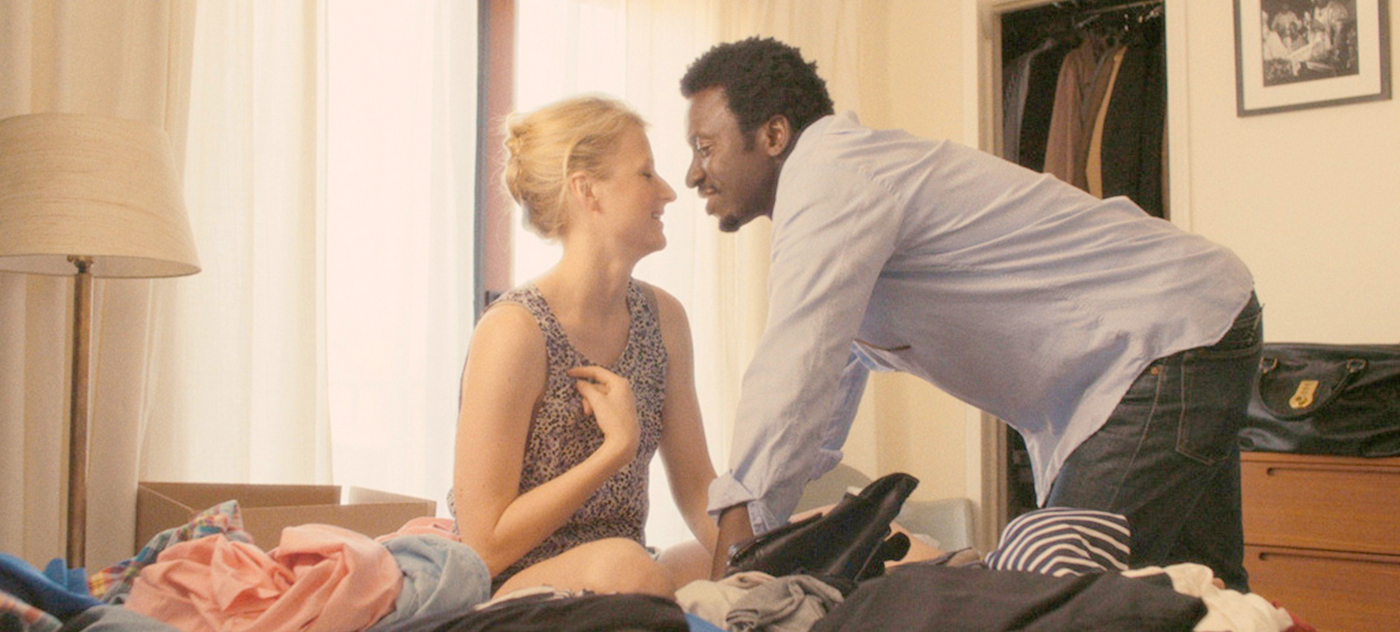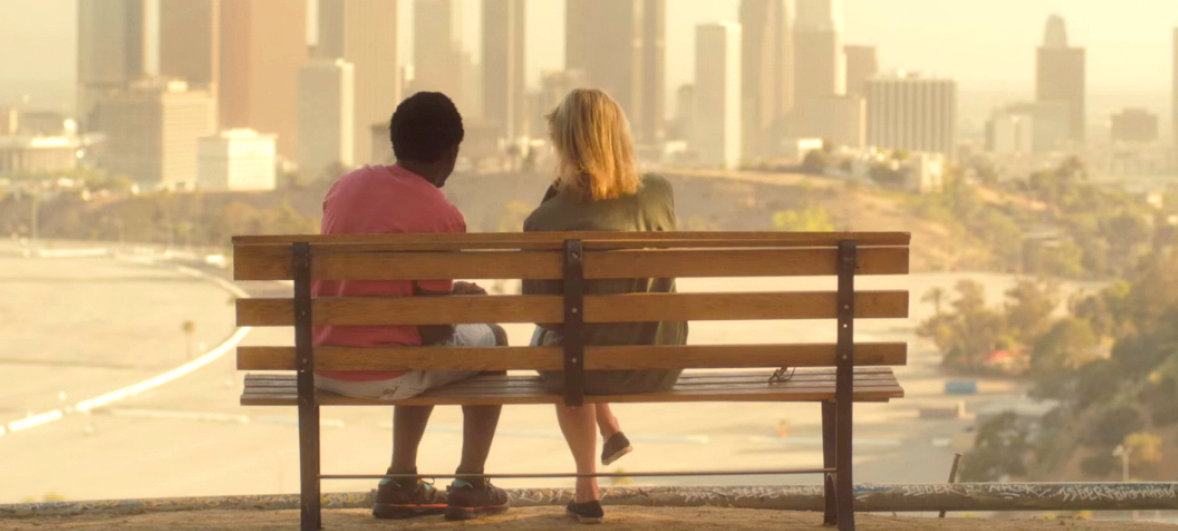By Andrew Cant (DoP). Meet Andrew on Facebook, Twitter, Instagram

Mamie Gummer, Anthony Okungbowa in a romantic scene from Echo Park (2014) by Amanda Marsalis
“I see a lot of indie features, shorts and I have to say that the production quality in the Indie scene is really high given the budgets and crew sizes we run. We should be very proud as a community of what we can achieve. There are times, however, when I see a film from a first-time Director, or first-time DoP, that breaks some of the most basic rules of film-making, and so I thought we should go over the basics of what to do (or what not to do) when making your film. These are in my order of importance, although I expect other people will have a different list” – Andrew Cant
As our reference, we used ‘Echo Park‘ (playing on Netflix), an indie film by Amanda Marsalis. Echo Park is distributed by Ava DuVernay‘s ARRAY.
Some of these points aren’t strictly in the realm of cinematography, but our first shoots are likely to be very small crews, or even solo ventures, so it’s worth mentioning them, as we may have at least some control over, or at least be able to contribute to, these areas. If you’re on a larger shoot where you don’t have influence over these areas, but you see them, you may want to reconsider working with some of the team on your next project. Either way, it’s all relevant in some form.
Echo Park Trailer from Amanda Marsalis on Vimeo.
1. Sound
This is first and foremost for me. If you have a poor picture, the audience may forgive you, if your sound is good. If you have bad sound, however, you’ve lost most of your audience after the first 3 minutes. For really small shoots the camera operator may also have to manage the basic sound recording. This is typically a mistake but sometimes unavoidable. If the camera operator is working hard to get a good shot, he’s not focusing on the sound quality.
Have someone else listen to the sound and if it’s bad on a take, for whatever reason, shoot another take. The Director should always listen to the sound from a take; all too often, they jump on the chance to review a scene on the monitor, but never reach for the headphones. On-camera mics are almost always a bad idea. The signal-to-noise ratio of the dialogue versus the background noise will be so poor that it will be distracting to an audience.
Ideally a shotgun mic on a boom or even wireless lavalier mics will give you a much better result. Rode sells a great wireless lav for the money which will pay for itself in no time. We’re almost never in full control over our filming environment in the Indie world so we have to work to isolate noise. A long shotgun (or rifle) is much more desirable than a short shotgun but this will need a good boom operator to use properly. Plan ADR as a last-ditch alternative.
It’s really hard to pull off properly and will burn into your time and budget. Don’t do it in post; do it right in production instead.
2. FOCUS
The capitals are on purpose! This is a no-brainer, but I see a lot of low-crew shorts or pilot episodes from first-time teams with really bad focus control. Rehearse the shot, plan your focus pulls, and get it right before you start shooting. If you get it wrong, do it again. After sound quality, bad focus will guarantee to kill your audience’s attention. Sure, there is a time to use focus as a tool for story-telling, but that’s not what I’m talking about here. It’s one thing to be out of focus on purpose to draw attention elsewhere or to give a feeling of confusion, but to be clearly struggling with maintaining a sharp focus on your subjects when sharp focus is needed – that’s inexcusable.
My Recommendation: If you’re new to pulling focus manually, try to get hold of a smaller-sensor camera first. Work on your shot composition and build your level of knowledge and skill in one area. Then go to a full frame or S35 sensor and practice focus pulling. Alternatively, do it the other way by getting onto bigger productions as a 1st AC and then graduate to Camera Operator. The trick is to not buy the first camera that you think will give you the “film look”, which will undoubtedly be a full frame Canon DSLR, slap a photo lens on it with motorised focus, switched to manual, and then try to learn it all at once. You’re setting yourself up with too much to manage and you’re likely to fail.

3. Camera Settings
This one is about the big settings: ISO, White Balance, and Exposure. Let’s start with white balance. All digital cameras come with white balance control – even a basic control. Understanding what this is and how it affects your recording is essential. There are also going to be times where you will change from optimal configuration for effect, but we need to get the settings right for the environment first, and then adjust if needed. White balance will change the temperature of the shot, and this will depend on the lighting. If the setting is too low you could end up with footage that looks very orange; too high and it will look blue. I’ll go over setting this properly in a future article.
The other two could just be considered exposure, but ISO also injects noise into the picture. It also has an impact on the colour rendition but again colour rendition is way down on the list. Noise isn’t though. We should aim to set ISO based on how we know our camera works best. Each camera is different in this respect. For me I know that my favourite camera loves ISO400 for several reasons. I know that ISO1600 and above though will give me more noise than I’m happy with.
Then there is exposure. There are a lot of ways to measure exposure, and most of them are good, and as long as you use one of them you’re going to be able to avoid this problem. Again, deliberately shooting low or high exposure can be a decision, but you need to be aware of your exposure level so you can calculate what you want. I will go through exposure in a future article too. For now, just be aware that exposure needs to be a conscious decision.

4. Camera Stability
No matter what style you’re going for with your shoot, even if you’re creating a “lost footage” piece, at some point you’ll want some steady shots. Your wide and establishing shots will want some degree of stability to them even if you’re closer-in shots need to be “shaky cam”. Every camera operator needs a camera tripod in their kit list. This is a basic requirement. If you’re going onto a film shoot and you’re planning to record everything handheld with your DSLR, do yourself a favour and have another think about it. It’s exhausting for audiences to process shaky footage. While this is a good thing for short periods, you need to give your audiences the occasional break from it. Also, no matter how great the write-up your camera and lens has on image stabilisation, I guarantee it won’t be enough. Get a tripod.
5. Over-Acting
Another one that’s not really our responsibility, but is worth mentioning for those on micro-shoots. For me (and considering I know very little about the art of acting), over-acting falls into two categories: over-expression, and; prolonged expression. The traditional view of over-acting is the former; over-expression. This is where an actor will exaggerate the facial or bodily expressions of an emotion, for example. I tend to refer to this as theatre acting versus film acting. Theatre actors need to make sure that the people at the back of the theatre can see their expressions, but on film the slightest inflection of a facial muscle can be seen on a close-up shot.
The latter, prolonged expression, is the one that is often overlooked. Genuine changes in emotion flash across our faces and bodies for less than a second before the emotion is processed and the visible signs of it decay back towards our natural expressive states. Prolonged expression is when an actor holds a given expression for several seconds or longer, often to ensure that the expression has been felt. This is very un-natural and can often be more distracting than over-expression. It’s another sign of inexperienced acting and is one to watch out for.

So there you have it. The top 5 items on my list of what can make or break a micro-shoot Indie film. The first two are the biggest ones. If you recognise one of the top two in your production, you have a real problem. If you have both, you really want to reconsider re-shooting your film. Any one of the others is a problem but as long as it’s just one you might get away with it. Ideally we don’t want anything on this list to be identifiable in our finished product. The trick is for us to be able to look on our own work objectively. Friends and family will often tell us what we want to hear so they’re not a good benchmark. Be critical, as your extended audience (certainly on the internet), will be.
Of course, the full list is much longer than just these 5 elements, but if you’ve avoided these 5 pitfalls you’re on your way to making something that people will at least sit all the way through. Happy filming and I’ll see you all next week.

